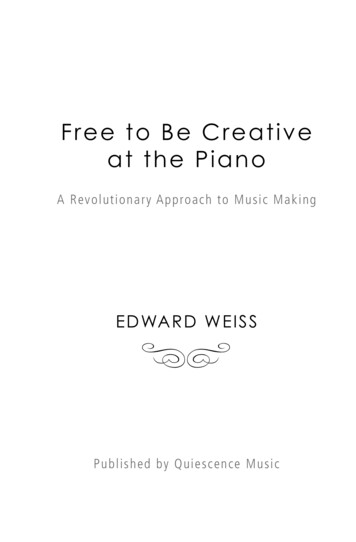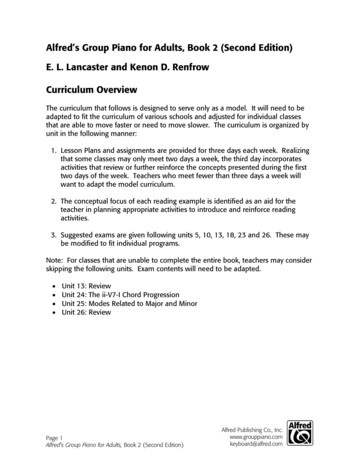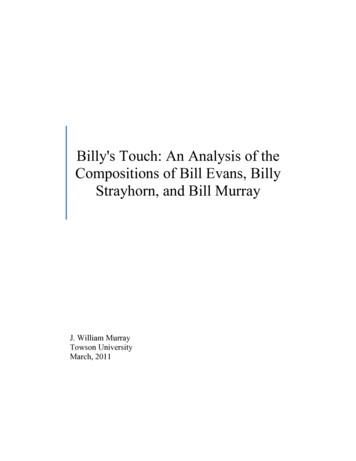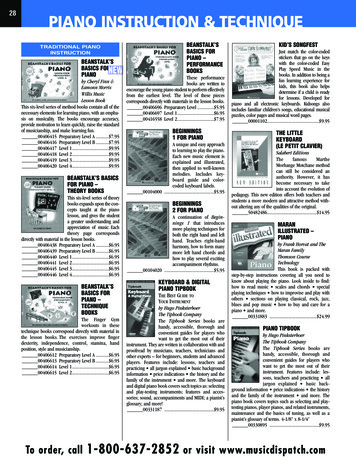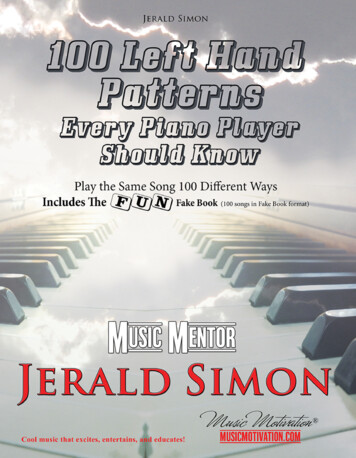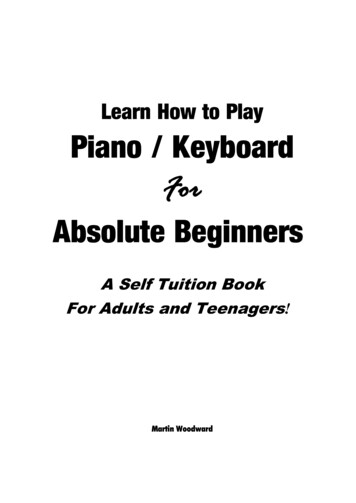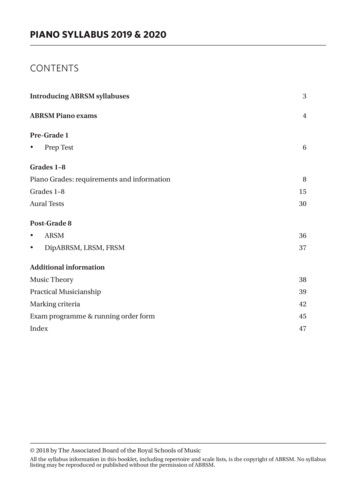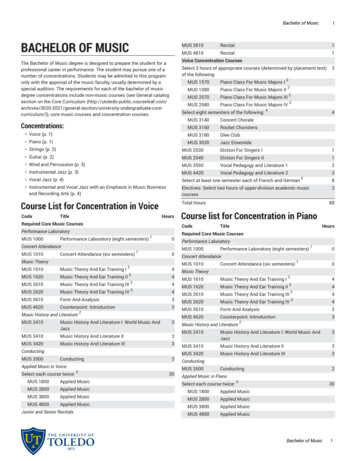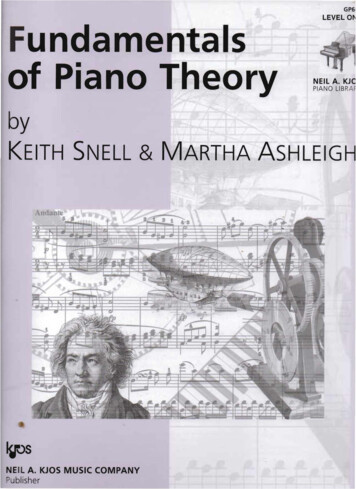
Transcription
GP61LEVEL Of' ,Fundamentalsof Piano TheoryNEIL A. KJOPIANO LlB RbyKEITH SNELL & MARTHA ASHLEIGHNEIL A. KJOS MUSIC COMPANYublisher
THE NEIL A. KJOS PIANO LIBRARYThe Neil A. Kjos Piano Library is a comprehensive series of piano music in a wide variety of musicalstyles. The library is divided into eleven levels and will provide students with a complete performance experience inboth solo and ensemble music. Teachers will find the carefully graded levels appropriate when choosing repertoirefor evaluations, auditions, festivals, and examinations. Included in the Neil A. Kjos Piano Library:Preparatory Level- Level TenFundamentals of Piano TheoryPiano Repertoire: Baroque & ClassicalPiano Repertoire: Romantic & 20th CenturyPiano Repertoire: EtudesScale SkillsEssential Piano RepertoireMusic of tbe 21st CenturyNew Age PianoJazz PianoOne Piano Four HandsMusic for ChristmasPREFACEThe study of music theory is an integral part of a complete musical education. Piano students who haveconsistent theory instruction will retain and interpret music more easily and accurately. Fundamentals of PianoTheory from the Neil A. Kjos Piano Library provides piano students with an organized course for the study ofmusic theory. Each volume contains essential rudiments of theory particularly relevant to the study of piano music.The appropriately graded levels present concepts in a clear, systematic manner to ensure steady and thoroughprogress as pianists advance in their understanding of music theory. GP661
CONTENTSPREPARATORY LEVEL REVIEWUnit I:Unit 2:Unit 7: TETRACHORDS AND MAJOR SCALESmLedger Line and Space Notes4Major Key Signatures C, G, D, F,Naming Notes on the Grand Staff5Minor Key Signatures A, E, B, D, GTIME SIGNATURE AND RHYTHMTime Signatures i, !, tDotted Note Rhythms6TripletTime Signature9mgTime Signature I31Unit 8: KEY SIGNATURESNOTE NAMING Unit 3:281011INTERVALS2nds, 3rds, 4ths, 5ths126th137th148th (Octave)15Interval Practice163436Unit 9: PRIMARY TRIADS: I, IV, V40Unit 10: TRIADS AND INVERSIONS42Unit 11: ACCOMPANYING A MELODYWITHIANDV44Unit 12: TRANSPOSING46Unit 13: SIGNS AND TERMS48Unit 14: FORM IN MUSIC52Unit 15: THE FOUR PERIODS OF MUSIC HISTORY 55Unit 4:ACCIDENTALSSharp, Flat, Natural18Unit 16: EAR TRAINING56Unit 5:HALF STEPS AND WHOLE STEPS19Unit 17: SIGHT READING58Unit 6:5-FINGER PATTERNS AND TRIADS20REVIEW TEST60 ISBN 0-8497-6254-5 1998 NeiJ A. Kjos Music Company, 4380 Jutland Drive. San Diego, California, 92117.International copyright secured. All rights reserved. Printed in U.S.A.Warning! The contents of this publication are protected by copyright law. To copy or reproduce themby any method is an infringement of the copyright law. Anyone who reproduces copyrighted matteris subject to substantial penalties and assessments for each infringement.
2Preparatory Level ReviewThe following two pages are a summary of the concepts and terms presented inFundamentals of Piano Theory: Preparatory Level.RestsNote ValuesHalf Dotted Half WholeQuarterJ. JEighth2 Eighthsnj)Quarter HalfEighth-- oTime Signatures 24 Eighths Dotted Quarter JJJWhole4:: .Treble clef'\r,"The Grand Staff I, Brace. . .t -," 4JILineslloI.,-."Spaces.Bass clef 4Doublbar IiiiIBar lineNotes on theStaffF GAB C D E F G,0IntervalsHarmonic IntervalsMelodic Intervals()2nd3rd5th4th2nd-e4th3rdo-e 5thSigns and TermsDynamics: p, mp, mf, f, cresco - :::::Articulation: accent , staccato, dim. , tenuto , legatoTempo: allegro, allegretto, andante, andantino, con moto, lento, moderato, ritardandoCharacter/Style: cantabile, dolceAdditional Signs and Terms: D. C. al fine, FermataGP661t:\,Slur , Tie JIJ, Repeat Sign'-'
AccidentalsNatural SignFlat SignSharp SignEllharmonic :\"oteslI!J lm lI!J l![ Whole StepsHalf Steps"""Major 5-finger Patterns and TriadsCM mI'I'a0GM m0.0I§ I0.0II0I 6 II ()A MajorD Major00F Major#n0nI#0111100()bo () I II IIEMajor#.o()I #11 II0#() 10()0116IIMinor 5-finger Patterns and TriadsG minorC minorI'e- obo00I II-I'0()boII0I b6 IIA minorD minor00F minor()0III H IIII00()['" boIII [,II IIn0I 6 IIE minor()0()I II II0#()0Major Scales .C MajorG MajorF MajorI' J J j J j J r FII j J r Fr F r r I J j J r F r r I!Key SignaturesiMajor Aminor GMajOr orE minorFMajOr orD minorGP661
4Unit 1Note NamingLedger LinesLedger lines are short lines added above or below the staff. Ledger lines extend the range ofthestaff up or down.Treble Clef Ledger Line and Space NotesI' JCJ J BArI' rAGBE [DCBass Clef Ledger Line and Space Notes12: r CDEg12:FJ J EDBC1. Name these ledger line and space notes.fII-I ,, "v f- . ,. -#f1I-f!-.t--' -#, ,,"vf!--f' -"111.l -.,.f-,}-f' -,}GP661 "111
5Naming Notes on the Grand Staff2. Write the letter name of each note.r\.:fl"ltVI,- ""A rr-J-.Ir:JfII .0. r'-'-J "I "lt./[l!- "'"'"""-'.,\.: VJtV I-/ -I""" "lt."I'"'ILJ-(T" I.-.r ", , r," V, tVGI--e U.f!: J . "" .,'/-"II r,"J "tV 111I-" .1'7 I .-. . "I-.-Ir-:j).J4GP661
6Unit 2Time Signatures and RhythmTime SignaturesThe time signature is the two numbers written at the beginning of a piece . The top nUlTlber tells how many beats are in each measure. The bottom number tells what kind of note gets one beat.In a time signature with a 4 on the bottom, the quarter note2 means two beats in each measure.I4: means the quarter note gets one beat. ,.The half note gets two beats.3 means three beats in each measure.4: means the quarter note gets one beat.Igets one beat. 1 beatJ ,. 2 beats 1 beatJ 2 beatsJ. 3 beats The dotted half note gets three beats.4: means four beats in each measure.4: means the quarter note gets one beat.I,. 1 beatJ 2 beatsJ. 3 beats The whole note gets four beats.Cis another way to write the time signature 4 beats0t.It is called common time.Rest SignsRest signs are used in music for silence. These notes have rest signs of the same value.JQuarter Note Half NoteQuarter Rest Half RestGP661aWhole Note0Whole Rest -- (whole measure rest)Eighth Notef;Eighth Rest
7Eighth Notes)'JOne eighth note looks like this:Two or more eighth notes are joined by a -beam. Eighth notes may be counted by saying "and" after the number.J1and2and1and2and3 and1 and 2J JJIand3and1. Write the correct time signature for each example.Write in the counts. Use a sign for the word "and".Clap and count the rhythms aloud.DIIJ.Dn.Jn---2. Draw bar lines to divide these rhythms into measures.Write in the counts. Use a sign for the word "and".Clap and count the rhythms aloud.n i n nJ.II
8Dotted Note RhythmsA dot on the right side of a note adds half of the value of the note.J. J The dotted quarter note may be understood when seen as a quarter note tied to an eighth note.Clap and count these rhythms. nn .Count:1and2and3and4and-3. Rewrite each measure of tied note rhythms with dotted note rhythms.Write the counts under the notes. Clap and count aloud.1 21 GP661 23 4 3 IIII
9TripletThe word triplet means three.The eighth note triplet is equal to one quarter note:Triplet rhythms may be counted in many ways. Clap and count this triplet rhythm in the wayssuggested below.Count:trip 11or:or:or:Iquarterlet-trip - let- 2 - 32- un - un2-trip - 2 - ee -trip3131Iletquarterlet3ee4144. Clap and count these rhythms. iJJJJJJJJJJJJJJ mn 5. Play and count aloud.1 /"";'" fa. ,, '" "",. V":::II:r'" . .J "" .""",., ./":::II:/.,- .,-' -.J--.J Ir-"I.u.I#-f' f'- 1#-.I.-"'}'".:I:5 I- I"'".(.--.J r-"-u,.I-'r-" Lf ./- .po.J1e.li.'lllLU-/-?3'"-- - -- -- -- - - -- I"".-.,, "" ,. --'-/?iI -.JIIf'- f' I.J.IIIIj r-". - r-" -.J-'-GP661
10Time SignaturegNotesRests6 means six beats in each measure.S means the eighth note gets one beat.1 beat itgA measure in can be dividedin half, creating a feeling oftwo pulses per measure.mgJ JJ3 beats t·J .hJ .hJ.J.6 beats-- Count:2 beats1or: 12342566. Clap and count this rhythm aloud.d. .Count: 1 23456123456123 456123 4 5 6I7. Write in the counts. Clap and count aloud.iI8. Add barlines to this rhythm.Write in the counts. Clap and count aloud.I,. Write in the counts. Play and count aloud.
11Time Signature38gRestsNotesmeans three beats in each measure.means the eighth notes gets one beat.)J1 beat 2 beats .3 beats -- B)( . not used in B)( not used in10. Clap and count this rhythm aloud. .Count: 113223121332I11. Write in the counts. Clap and count aloud.--- I12. Add barlines to this rhythm.Write in the counts. Clap and count aloud.I13. Write in the counts. Play and count aloud." . . .J r " v1I:"4tJtIII; . - 5[ 4."' -."" [ .'"''''",-.nv0 J . ( 1 - .J-. ---.If-:.GP661
12Unit 3IntervalsAn interval is the distance between two notes.Melodic intervals are two notes played one at a time.Harmonic intervals are two notes played at the same time.Harmonic IntervalsMelodic Intervals3rd2nd5th4th2nd3rd4th5th1. Name these melodic intervals (2nd, 3rd, 4th, or 5th).12:Jr Ir r I J r I J r Ir r Ir r Ir J Ir r I2. Name these harmonic intervals (2nd, 3rd, 4th, or 5th).I'gs,,00::ngon3. Draw melodic intervals up from the given note3rd5th4th2nd3rd4. Draw harmonic intervals up from the given note. . -/'GP661I'lJ.,.,.'-'!.,."-'lJ3rd5th"-'3rd5th2nd4th
136ths6ths on the staff6th on the keyboardI' JcIIT j I I njMelodic 6thsAHarmonic 6ths6ths on the keyboard skip four white keys.6ths on the staff move from a space to a line or a line to a space.Melodic 6ths5. Draw a melodic 6th up from each given note. Use quarter notes. Name each note. I "tJI,iI'-'v. I I.6. Draw a melodic 6th down from each given note. Use halfnotes. Name each note.IfHarmonic 6ths7. Draw a note above each given note to form harmonic 6ths. Use whole notes.N arne the notes. I,I"'-' JtJ() '-'8. Name each interval (3rd, 4th, 5th, or 6th). l '-'u
147ths7th on the keyboardc7ths on the staffMelodic 7thsBHarmonic 7ths7ths on the keyboard skip five white keys.7ths on the staff move from a space to a space ora line to a line.Melodic 7ths9. Draw a melodic 7th up from each given note. Use quarter notes. Name each note.--./ .-]I.- 10. Draw a melodic 7th down from each given note. Use halfnotes. Name each note.Harmonic 7ths11. Draw a note above each given note to form harmonic 7ths. Use whole notes.Name the notes. : .- I '-)f'-JC"tIo'--"I""!II.'--"U12. Name each interval (3rd, 4th, 5th, 6th or 7th).-- 14Jr 1rJ 1JrJ J1:8
15Octaves (Sths)Octaves (8ths) on the staffOctave (8th) on the keyboard1& j:; I :Melodic Octaves (8ths) Harmonic Octaves (8ths)FFr Ir J IOctaves (8ths) on the staff move from a space to a line or a line to a space.Melodic Octaves (Sths)13. Draw a melodic octave (8th) up from each given note. Use quarter notes.ft I J - .@) I14. Draw a melodic octave (8th) down from each given note. Use half notes.I ·(f; 01- ./I f-'--.f-ItE IHarmonic Octaves (Sths)15. Draw a note above each given note to form harmonic octaves (8ths). Use whole notes.f1I r " " VI I.J U16. Name each interval (6th, 7th, or 8th).'-J'-"-e
16Interval Practice17. Name each interval. Name each note.o()()no()oI':nn()18. Draw each interval. Name each note.5th up3rd down2nd down3rd up5th down6th up6th up2nd down7th Down7th up4th down-, ",",- / "110.'-"4th Upo
1719. Write letter names to form 3rds going up.A20. Write letter names to form 4ths going up.G021. Write letter names to form 5ths going up.F22. Write letter names to form 6ths going up.E023. Write letter names to form 7ths going up.D24. Write letter names to form 3rds going down.c25. Write letter names to form 4ths going down.B26. Write letter names to form 5ths going down.A27. Write letter names to form 6ths going down.G28. Write letter names to form 7ths going down. F0
18Unit 4Accidentals:Sharp, Flat, and NaturalAccidental is the name for any sharp, nat, or natural that appears in music. When an acci dental appears in music, it lasts for an entire measure. The bar line at the end of a measurecancels the accidentaLSharp Sign#A sharp sign means to play the very next key higher.1. Draw a sharp sign before each note. Name each note."n.,.,.'-'I'-" r I.)I.)"tV"VI '-"Flat Sign A flat sign means to play the very next key lower.2. Draw a flat sign before each note. Name each note.oo()oooNatural Sign A natural sign cancels any sharp or flat.3. Draw a natural sign before the second note in each measure. Name each note.I rJ 0II[J . 11.JJ.J. "tV r:.-.11 L1.:rt Enharmonic NotesNotes that sound the same but are written differently are called enharmonic notes. ""4. Draw the enharmonic note for each given note. Name each note. , 1II 1JtVGP661Ih 1/- L1J.J.O11.",.- L"'. -I'r f1'7
19Unit 5Half Steps and Whole StepsHalf StepA half step is the distance from one key the very next key with no key between.1. Draw the note a half step above each given note. Use quarter notes. Name each note.-Lli , "" ".I--I lJ.,I11v 2. Draw the note a half step below each given note. Use half notes. Name each note.,"".- I·- / L.L-H"I"\c.,lJ.O.,.1"\.;r 11IrJ r:.,IIWhole StepA whole step is the distance from one key to the next key with one key between.3. Draw the note a whole step above each given note. Use whole notes. Name each note.4. Draw the note a whole step below each given note. Use half notes. Name each note. .- I·/Qr:.,Ih-'lv r- I"\.,.-H"I"\ f IrJ riteH for half step and W for whole step.r-
20Unit 65-Finger Patterns and TriadsMajor 5-Finger PatternsMajor 5-finger patterns have five notes formed in a pattern of whole steps and half steps.The half step is between the 3rd and 4th notes of the 5-finger pattern.W whole stepH half stepC Major 5-Finger Pattern()oww0HI ()WD Major 5-Finger Pattern()o0WWHWA 5-finger pattern may begin on any note. The lowest note names the 5-finger pattern.1. Draw the notes of these Major 5-finger patterns. Use whole notes.C MajorG MajorD MajorA MajorE MajorBMajorI!J IiIJ "-I.JJ.JF# MajorC# Major- .iiIi
21-/.Gb MajorDb MajorAb MajorEb MajorBb Majorf1F MajorI I' "'-' J.J2. Name these Major 5-finger patternsRemember that the lowest note names the 5-finger pattern.ctr rGP661
22Major TriadsA triad is a three note chord.The 1st, 3rd, and 5th notes of a Major 5-finger pattern form a Major triad.The notes in a triad are called the Root, the 3rd, and the 5th.CMajor315-Finger PatternG Major153Triad5-Finger Pattern3. Draw each Major 5-finger pattern.Draw each Major triad.-.CMajorG MajorD MajorA Major-GP661.B MajorEMajorF# Major5IC# MajorTriad
23G MajorA Majorf1D MajorE MajorI ,, ".J",J-/.B Major-.F Major4. Name each triad.#11Broken TriadBlocked TriadTriads may be broken or blocked.The root, 3rd, and 5th of a broken triad may appear in any order.5. Name these broken triads.GP661
24Tonic (I) and Dominant (V)The first note of a 5-finger pattern is called tonic.The fifth note of a 5-finger pattern is called dominant.Roman numerals are used as symbols for tonic and dominant.V DominantI TonicC Major 5-Finger pattern I: ? : . oE ( ) o · 1 :: t: GvI6. Turn back to pages 20 and 21 and label the tonic and dominant notesof each 5-finger pattern with I and V.7. Name the tonic (I) and dominant (V) notes for these 5-finger patterns:C MajorG MajorD MajorA MajorEMajorB MajorIIIIIIVVVVVVF# Major IVEnhannonic to:Did you notice that the dominant (V) of each5-finger pattern became the tonic (I) of the next?Did you notice that you began and ended with C?Qb Major IVDb MajorAb MajorEb MajorBb MajorF MajorVC MajorF MajorIGP661vVVVG MajorIIIIIIIvv
25The Circle of SthsWhen you move from the tonic (1) to dominant (V) of each 5-finger pattern, you are moving upby the interval of a 5th. The 5ths in order, beginning and ending on Care:CG-D-A-EB -1F#Gb1- DbEb-BbAbF -C(enharmonic notes) C /FGBb!\ DCircleof5thsEb\A)Ab EB/o ----------At the Piano 8. Start at the lowest C on the piano and play tonic (1) to dominant (V) 5ths going up.You will end on the highest C on the piano!9. Play each 5-finger pattern around the Circle of 5ths.5-Finger Patterns Around the Circle of 5thsF# G# A# B C#B C# D# E F#E F# G# A BA B C# D ED E F# G AGABCDF G A Bb CCDEF GBb C D Eb FEb F G Ab BbAb Bb C Db EbDb Eb F Gb AbGb Ab Bb cb DbGP661
26Minor 5-Finger PatternsTo change a Major 5-finger pattern into a minor 5-finger pattern,lower the third note one half step.C minor 5-Finger PatternC Major 5-Finger PatternIf the third is a natural note, it will become a flat note.If the third is a sharp note, it will become a natural note.10. Draw these Major and minor 5-finger patterns.CMajorC minorG MajorG minor- ,.D minorDMajorA Major1- GP661.A minor-
27E minorE Major.F minorF Major-iIII'Bb minorBb Major11. The notes of a 5-finger pattern may appear in any order.Arrange the notes of each phrase into a 5-finger pattern.Name the 5-finger pattern you have drawn. The first one is done for you. .G minor . -/I' .-./ . GP661
28Minor TriadsTo change a Major triad into a minor triad, lower the 3rd one half step.If the 3rd is a natural note, it will become a flat note.If the 3rd is a sharp note, it will become a natural note.CMajorEMajorC minorEminornReminder: The bar line cancels any accidental in the measure before.It is not necessary to draw the natural sign.12. Draw these Major and minor triads.C Major.DMajor-C minorDminor.F# minor .- A MajorG minorF MajorA minor'-'-------'-------'Ab MajorB Major.EMajor-Db minorF# MajorG MajorAb minorF minorE minorEb minorB minor.Bb Major-Bb minor
2913. Name these Major and minor triads. M Major,m minorIUl'eM'UGmII14. Triads may be blocked (as in the examples above) or broken.The root, 3rd, and 5th of a broken triad may appear in any order.Name these broken triads.n()n()oo oonn()GP661
I\tajor Maze15. Follow the Major triads and 5-finger patterns through the maze. Start at Da Capo("from the beginning") and finish at al fine ("to the end"). Be sure to watch the clef signs.Da Capo\I':()#0 () I I alfineP1
31Unit 7Tetrachords and Major ScalesA tetrachord is a group of four notes formed in a pattern of whole steps and half steps. *The pattern for a Major tetrachord is whole step - whole step - half step (W - W - H).C Major TetrachordoWG Major Tetrachord0w()o()wwH()0HMajor scales can be formed by joining two tetrachords. The 1st tetrachord is called the tonic tetrachord. The 2nd tetrachord is called the dominant tetrachord. The two tetrachords are joined by a whole step.C Major ScaleITonic TetrachordwowwHwno()o()0Dominant TetrachordwHDrawing Major Tetrachords and Scales1. Draw each Major tetrachord. Then, draw the Major scale by joining the tetrachords.(The first note of each tetrachord and scale is drawn for you.).C Major Tetrachord .-./Ii{]I-.G Major TetrachordjJJIC Major Scale* The first four notes of a Major 5-finger pattern form a Major tetrachord.GP661
32D Major TetrachordG Major Tetrachord17Jo0G Major ScaleoD Major Tetrachord,fI r"'-' JutJA Major Tetrachord, D Major Scale,"" , "tJv0F Major Tetrachord""IIII , , ".vF Major Scale, '-"0'-' J 0rC Major Tetrachord "J{ B 17JF Major TetrachordMajor TetrachordoboB Major Scale GP661
332. Add the correct sharps or flats to form each Major scale.Circle the half steps in each scale.G Major "II '" -."ltVWI.-,.,.-- ffI-"I w '" .,ltV,"'Lf- .-II .,.I ., - I.-I-J I- - -- --., I w."'"'"tVI-., . 1"--f' -f'----- - -.,- ., - - - .IJ I- - I.-II-- I!-I1" - r .-II.,-I--I I- II.-I-.-I-- .-I---.,- II--IJ IIIJ I I. I-IIIII-J I.-I"- II,"". I- I tt -F Major/ J D Major/-I- I.,.-II-.,- Bb Major w."'""tV .-.,.-,;.-- --.-I.,-.Ir II- -- --J --IJ I II -.-I--.-IR-,;- - - - IJ .-IIIGP661
34Unit 8Key SignaturesThe key signature is the sharps or flats at the beginning of each staff. It tells you: notes to be sharp or flat in a piece, and the tonic note, or key, of the piece.Major Key SignaturesCMajorGMajorNo sharps or flatsOne sharpD MajorTwo sharps '\ oM /I " ""tJI :""I-'.I-'tJI JJ I " a, , II Ii.,;0. firB FMajorI . "t .;F,""I-'One flatvIhIh) ,-,.I, F,""VTwo flatsIrJhI-'"tJ." ,avMajor, vIIh1. Name these Major key signatures.", '"FI-'Iv,F,I I.;(I.,. "F'I-'IIIJ(II. """oM .I ,-,.-,. ., firihV.","oM .F,F,II'GP661IIIhvII'"IIJI.; I . "" I ", .,.I , ., IIhv
352. Draw each Major key signature three times.,,.,.GMajorI ,"r\.' Ji ",. . rJ4Vi -"4V '"'",.D MajoriI , " ."'-' l/i@. ",.-fi, ,.t.::. . ,-f r" J@.,-".f T , I,-,.l/r .J., ",.I , ,\.: J.J.'" ,.-"'-' u@. .1- ifI,.flfl.,.flBb MajorI"'-' J@.IF Major r I @.Jf,.,J,.I , tV""\.: U.'" .-GP661
36Minor Key SignaturesEach Major key signature has a relative minor key signature with the same sharps or flats.E minorOne sharp(Relative to G Major)A minorNo sharps or flats(Relative to C Major) / /B minorTwo sharps(Relative to D Major) ,j,j.ofI"r, I f "',. I"'"ofI"fD minorOne flat(Relative to F Major)GminorTwo flats(Relative to Bb Major) "vr h"It)I"',.I . / .I :,. ./V'\Iflh""It),."", ofI"f/" "v "'" u."tJr,"vt.JIfl h"3. Name these minor key signatures. """ItJr,'\I "',. "'"I '" ,. ,cI I ". II,.r.""It)v -'.," " "'""tJhJ ofI"-'hV-'U.'\ / ,j,j.I r, "t)I",'-.' V r "v"t)Ihv I , . -'GP661oM'ofI".,I"".I fIJhv
374. Draw each minor key signature three times.E minor,;""f'lT".J.J,".J"t:. , .",,"",. . .fl I,;, .J-.7'I ".I."-J-.7'B minor,,;""I J ,. -.7',."T LJ"'-.: lJtJ@).J .I"''' . .,--T 7'D minorII, PI\J".J .""".7', fl,. . v.;. .-7'flT,.'-.: U "4V-. .7'"G minor ", "LJ.J . 'l,f'lfI,. "tV'-' J.""-,-.7'f'l7,. lJ ".J ,.i I GP661
385. Play each example and detennine if it is Major or minor.Name each key signature.Keyof 411:' .,"- - -"v u,."- v1. tV'" " u,.vf::. II;.:.,.-J",.-.iI 5Keyof- --1 J, " 0,." v ltVII --r-" . -- -. - . -,. :--.--.r6. t -II ,,,,.4IiJ,. U./ .-II:;;.;- 4 ----Keyof ,j.j.:I',II'","'''''.5,.-"---- . .-I, "- V. ."'""' . .,.,f,.--.-,.--.,.-1--.-I-.,.I 2- - ,tV(I"' . 'i'I' fW,./ ---: r-II 3GP661-,.---. -' . .:. . "'-'I fWI-.:.",. Keyoff'I,j.j.-. -.-I-"""I-. --'If':J':J';I-
39Key of '\oW-,. , ""'"tV" I I . .loP ,.,,.--- oW '":It7"2-I- --.,I i' -1.-1 . -R --n3Key of3Key 0 f1" I. .---, " , vh\. IJ ----.Clrt." v 7,."'.-::;: I""--- --- - 1.-.---- u.- W"-".l"!II5Keyof5GP661
40Unit 9Primary Triads:I, IV, and VTriads built on the first, fourth, and fifth notes of a scale are called primary triads.Primary triads are labeled with Roman numerals: I(one), IV(four), and V(five).In a Major key, the primary triads are Major triads.Triads in CIVIV1. Draw the Major scale.Draw the primary triads on the first, fourth, and fifth notes of the scale.Label the triads with Roman numerals (1, IV, V).CMajorf1I I, !I\/" -e .G Major-ii!D MajorflIJ! ,'""11 !U.IF Major -!IuGP661I
41Bb Majorfl!I !I," "Jon2. Draw the primary triads for each key in treble and bass staff.Example: C MajorG Majorftfl Ir tV"'-'11i,-."" . "tV,-. I'-' Jt)-'"- ,./ I - !- I-.,. ./i'IIVVIIVVIIVVIIVVFMajorDMajorf1 I I" '-'\J---./ .I'IIVVBb MajorCMajorIIVVGP661
42Unit 10Triads and InversionsA triad is in root position when the root of the triad is the lowest note. A triad in root position may appear two ways on the staff:line -----O -- 5thline03rd or:line0Rootspacespacespace--I7""l.---5th3rdRootAn inversion is created when the notes of a root position triad are rearranged. A triad is in 1st inversion when the 3rd of the triad is the lowest note. A triad is in 2nd inversion when the 5th of the triad is the lowest note.root1st . h3rdECG3rdroot5th1. Draw the notes of these triads in root position, 1st inversion, and 2nd inversion.CMajorRoot position1st inversion2nd inversionflII'-' /G Major1 -.i-I 1/1'.F Major -GP661IiiJ
I43Root position1st inversion2nd inversionD MajorflI ilir "1"11 A Major-, /E MajorI,"" i Ir I"VDb MajorfJ Ii' "I"V Ab Major.- . -i/Eb Major,TTl"vI" " I GP661
44Unit 11Accompanying a Melody withTonic (I) and Dominant (V)Melodies which use the notes of a 5-finger pattern may be accompanied by the tonic (I) anddominant (V) notes of the same 5-finger pattern.Tonic (I) accompanies measures that mostly use triad notes (the 1st, 3rd, and 5th notes ofthe 5-finger pattern).Dominant (V) accompanies measures that mostly use non-triad notes (the 2nd and 4th notesof a 5-finger pattern).This melody uses the notes of the C Major 5-finger pattern.The tonic note is C. The dominant note is G.The triad notes are C, E, G. The non-triad notes are D and F.",I " """ iJ:::E tJ,Ii. ". "':::E 135.--. .".-ITriad Notes.-I42- Non-Triad Notes.,r;;,- . -. -.-(') ,III vvIIWrite an accompaniment for the following melodies using tonic (I) and dominant (V).1. Complete the sentences above each melody.2. Label measures that mostly use triad notes with 1Draw the tonic note in the bass clef. Use whole notes.3. Label measures that mostly use non-triad notes with V.Draw the dominant note in the bass clef. Use whole notes.This melody uses the notes of the5-finger pattern.The tonic note is. The dominant note isThe triad notes are. The non-triad notes areand / I.J I: '"v . I: @) 1.-.· .- -- - - . .,., . JfGP661JI:. t . I - - . -6
I45This melody uses the notes of the 5-finger pattern.The tonic note is. The dominant note isThe triad notes are . The non-triad notes are and 10M"- fi \.' JtV. r . : . : . r.-. . . : . - - ."'"- oM"'"This melody uses the notes of the 5-finger pattern.The tonic note is. The dominant note isThe triad notes are . The non-triad notes are and I h';; !,\Vfiv\.: ttJ - - . -- - \.(';"J "",.- I'"hvThis melody uses the notes of the 5-finger pattern.The tonic note is. The dominant note isThe triad notes are . The non-triad notes are andf\I f!'\\.:v@) . .-. tt!.'": I:I"' · t".,. t!.','"IIr--.f.I. . - -- -:,; I:GP661
46Unit 12TransposingTranspose means to play in a different key than written.To transpose music, play the same pattern of intervals beginning on a different note.This piece is in the key of C Major."1,., " ,. ".J'"%'"%.,. ,.,.I. '"%/ -l. -'WI'nr;,;-t 5IIr;,;"::II:. - -(I';}51. Now transpose the piece to the key ofF Major. . III'IJIh. . I:'" vVJLI:@) ",.-J I./ vGP661. I:J&. I: 1"\t I.I -.-9,':JIIHere is the same piece transposed to the key of G Major.1::;;r
,2gSU! ,3442X 47Are Yon Sleeping?Here is "Are You Sleeping?" in the key of C Major. r1.,. "::E",."::E"l.vI--I 542- - , .-I,r.-II" "l.v1I."I '" ".-I,-.lII. -- - -. .-I - - --I1I2 1.;.- "'"Iu31 t.,---I'"'"t.Ju -,.,I-"":::II: F .l- I .,.'" ". ,.".30----':JI';J I'"'"---I'"'IU2. Transpose "Are You Sleeping?" to the key of D Major.fl/I ti'l'iJ.JJ. r ,"-IIjI .,/I-jI .I-@.J ! I"".""J' - !'l.l.L lI/ll.JIL IIflII I!, "VIf !' l.l.1l.11I i""."" 1l. '"' 11I.,""I"'J11GP661
48Unit 13Signs and TermsDynamicsDynamic signs tell how loud or soft to play.SIGNMEANINGplamssImoppvery softplanopsoftmezzo planompmedium softmezzo fortemfmedium loudfortefloudfortissimoffvery loudI TERMcrescendo (cresc.)gradually louderdiminuendo (dim.)gradually softerArticulationArticulation signs tell how to touch and release the keys.I TERMaccentlegato GP661SIGN MEANINGstrong emphasissmooth, connectedstaccato short, detachedtenuto-hold full value; slight emphasisr
I49TenlpoTempo marks tell how fast or slow to play.TERMMEANINGallegrofast (also means cheerful, happy)allegrettosomewhat fast (slower than allegro)andantewalking tempo (flowing)andantinoslightly faster than andantecon motowith motionlentoslowmoderatomoderatelyritardando (rit.)gradually slowerVIvacelively, quickVIVOlivelyChanging Tempoa temporeturn to the original temporitardando (rit.)gradually slowerCharacter or StyleThese words help establish feeling, mood, or performance style.I TERM'"MEANINGcantabile.m a smgmg mannerdolcegently, sweetlyglOcosohumorousscherzandoplayful
50D. C. al FineD. C. al fine means to play from the beginning to the fine (end).D. C. is the abbreviation for Da capo, which means from the head.In music, D. C. means to play again from the beginning. Fine means end.Fermata Sign /":\Fermata means to hold a note longer than its time value.Grace Note)rA grace note is printed in small type. It is not counted in the rhythm; it is played quickly,almost together with the next note.Slur A slur is a curved line over or under two or more notes that are to be played legato.Legato means to play smoothly connected.TieJ IJ .A tie is a curved line that connects notes on the same line or space.Play only the first note and hold it for the value of both notes.Octave Sign 8vaWhen the octave sign is placed over notes, play them one octave (eight notes) higher thanwritten. When the octave sign is placed under notes, play them one octave lower than written.Pedal Sign, - - I- - 'The pedal sign shows when to press and lift the damper (right) pedal.Repeat SignsRepeat from the beginning.1.2.:11.3.GP661III I----:- -I:Repeat between the pairs of dots and double bar lines.Play the first ending and repeat from the beginning; thenskip the first ending and play the second ending.
51Matching and Crossword PuzzleI. Draw a line to match each meaning or sign with its term.Termstiegradually slowerritardandoaccentstrong emphasislegatoa tempofast, cheerfultenutostaccatosmooth, connectedallegrocantabilegradually softerrepetitionpIamSSImoshort, detachedD. C. al Finecrescendoplay from the beginning to the fine.fortissimodiminuendo8va- - mezzo fortemezzo pIanoSslur4:octave signtime signaturevery loudAcross2.6.8.9.11.14.15.16.18.20.2. Write the term for each meaning or sign inthis crossword puzzle.18219Down-l. gradually louder3.J IJ 4. repeat of a
The study of music theory is an integral part of a complete musical education. Piano students who have consistent theory instruction will retain and interpret music more easily and accurately. Fundamentals ofPiano Theory from the Neil A. Kjos Piano Library provides piano student
